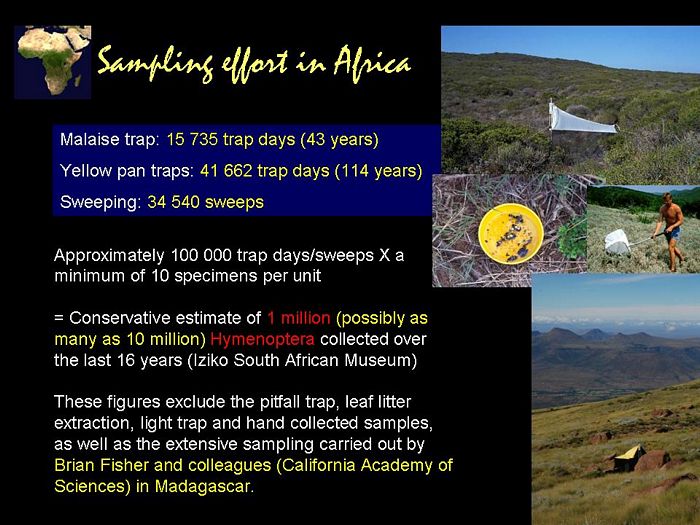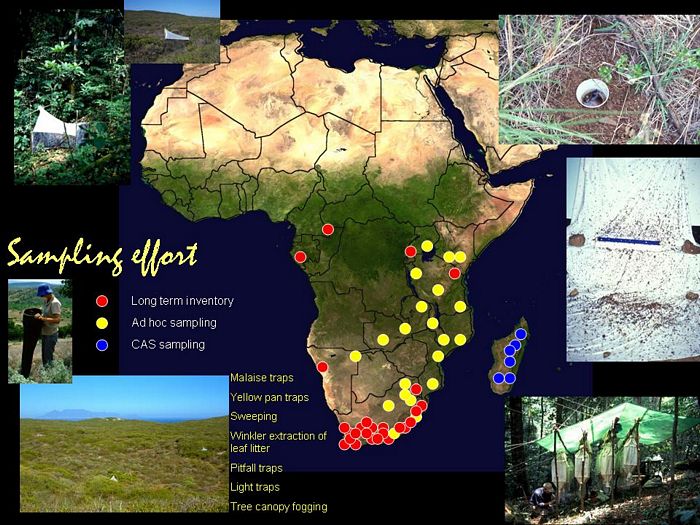Motivational overview
Insects are a vital
component of any ecosystem from both an abundance and species
richness perspective, as they represent the bulk of all animal
diversity. From conservation perspectives insects are important
pollinators, playing a critical role in the maintenance and
evolution of floral species richness, and have the potential to
play a valuable role as indicator species in conservation and
ecological monitoring. Hymenoptera (wasps, bees and ants) are an
extremely important group of insects from both an economic and a
conservation perspective. Parasitoid wasps play a vital
ecological role as natural controllers of insect populations,
including those that are detrimental to agriculture, forestry,
and human and animal health, and have vast potential for use in
managed bio-control programs. Wasps and bees are also important
pollinators, playing a critical role in the functioning of any
ecosystem. Some wasps and ants are pests, while others, such as
the honeybee, provide beneficial resources. Ants are valuable
indicator species in conservation and ecological monitoring. To
manage and conserve wasps, ants and bees, we need to inventory
the species that are involved, a prerequisite to understanding
the role that they play in ecological processes.
The Hymenoptera,
particularly the economically important Parasitica, are poorly
known from a taxonomic and species richness perspective, with an
estimated 20% or less of the extant species known to science.
Current estimates
of described world hymenopteran species richness tally at 154
000 (Aguiar
et al, 2013, Huber, 2017), of these only about 20 000 described
species are known from the Afrotropical region (van Noort, in
prep.). A conservative extrapolated estimate suggests there are
as many as 100 000 species, with a possibility that the total
may be as high as 500 000 species, in the Afrotropical region
alone (van Noort, in prep). The same holds for South Africa,
where only 6 000 hymenopteran species are described of an
estimated 30 000 – 120 000 species (van Noort, in prep).
With current rates of environmental degradation and habitat
destruction, inventory of undocumented species from
under-sampled or threatened habitats is a matter of urgency.
Comprehensive biodiversity inventory surveys are increasingly
being implemented in the Afrotropical region to collect and
describe the wealth of new species. However, a major hurdle in
the inventory process is the lack of a synthesized taxonomic
resource to enable identification of this rich fauna. Pertinent
information is available for many groups of Hymenoptera, but
this information is scattered through the literature and not
readily accessible. The majority of available taxonomic
treatments and identification keys are out of date.
Online user-friendly
identification resources, synthesizing our current state of
knowledge, are required to facilitate and streamline the hymenopteran diversity inventory process in the Afrotropical
biogeographical region. |
Scientific background
Species richness
The Hymenoptera
(wasps, bees & ants) are an extremely species rich and abundant
group of insects, with only the Coleoptera and Lepidoptera,
having more described species (Arnett 1985). However, the
perception that the Hymenoptera is less species rich than either
the Coleoptera or Lepidoptera is likely to be a function of
disparate taxonomic attention, a contention supported by more
recent investigations of local insect species richness. In some
temperate regions the Hymenoptera is the most species rich of
the insect orders (Gaston 1991) and was shown to have the
highest species richness in tropical forest canopies (Stork
1991). Globally the number of described species of Hymenoptera
was previously estimated to be 115 000 (Gaston 1993; Grissell 1999; LaSalle
& Gauld 1993), but a recent assessment places the number of
extant described species at 153 088 (Aquiar et al. 2013;
Huber, 2017). Taxonomic knowledge of Afrotropical Hymenoptera,
as it is on a global basis, is in its infancy at species level.
An indication of just how poor this knowledge is can be gleaned
from the current taxonomic status of the Afrotropical
Ichneumonidae, which can be used as a benchmark for
extrapolation of hymenopteran species richness. Species richness
and diversity of Afrotropical Ichneumonidae is poorly known.
There are currently 363 described genera (world c. 1 600 genera)
and 2 102 described species (world c. 25 000 species) in the
Afrotropical region, but I estimate that there are about 20 000
species in total, hence we know about 10% of the fauna, whereas
on a global basis an estimated 25% of species are described.
Historically about 800-900 species have been described every 50
years since the first African species was named in 1758, but in
the last 20 years we have only described 162 species. These
contemporary systematic treatments have allowed for an
assessment of the degree of knowledge for the undiscovered
fauna, with revisions at generic level resulting in a 10-100
fold increase in species richness. However, this is still an
underestimate of true richness for these groups, as revisions
are based on existing specimens in museum repositories emanating
from an extremely inadequate sampling of the ecosystems in the
region, and hence represent a small fraction of the actual
extant species richness. The vast majority of African vegetation
types and habitats have not been adequately sampled and most
ichneumonid species still remain to be collected, a situation indicative of
global hymenopteran species richness assessment. More than 95%
of quarter-degree grid cells still have not been sampled, or
have only had superficial ad hoc sampling conducted in them.
This short-coming is exemplified by high species turnover
between sampling methods within a locality in existing inventory
surveys. To fill these massive sampling gaps requires
implementation of intensive long-term, continuous inventory
regimes, using a diverse and comprehensive range of sampling
methods with a high degree of spatial and temporal coverage to
efficiently document species richness. This is a critical need,
particularly given the rapid escalation in habitat
transformation, largely as the result of anthropogenic impact. Based on estimations of the
richness of Costa Rica’s hymenopteran fauna in relation to
estimates of global hymenopteran richness, it seems likely that
around 11-13% of the world hymenopteran fauna has been described
to date (Gaston et al., 1996), although other estimates have put
the figure as low as 4-5% (Gauld & Gaston, 1995; Stork, 1997).
Whichever estimate is more accurate it is clear that the
Hymenoptera are taxonomically poorly known. In light of this the
estimate that 16% of the Afrotropical ichneumonid species have
been described can be feasibly extrapolated to the rest of the
Afrotropical hymenopteran fauna which includes 65 families,
incorporating 2000 genera and 18 374 species,
resulting in an estimation of a total of 115 000 species (van
Noort, in prep). The
figure could, however range from a relatively conservative 90
000 species up to as many as 460 000 species.
Sampling effort
and curatorial challenges
The proposed
outputs of the Afrotropical Hymenoptera Initiative
will address the fundamental lack of knowledge of hymenopteran
diversity in the Afrotropical region. Historically there are
important Hymenoptera collections from the region that are
housed in a number of European Museums including the Natural
History Museums in London, Paris, Tervuren and Munich to name a
few. There is also a wealth of
recently sampled Hymenoptera residing in African and USA museums. Simon van Noort (Iziko
South African Museum) and Brian Fisher (California Academy of
Sciences) have implemented numerous structured insect
inventory surveys across Africa (Gabon,
Central African Republic, Namibia, South Africa, Tanzania,
Uganda) over the last 25 years. Brian Fisher has also
carried out extensive sampling in Madagascar. Bob Copeland
affiliated with the National Museum of Kenya and the Systematic
Entomology Lab, USDA/ARS in Washington DC is currently running
an extensive Malaise trapping program in East Africa. Mike
Sharkey (University of Kentucky) recently ran a survey in Congo.
Ilari Sääksjärvi and colleagues in Turku are running an
intensive Malaise trap inventory survey of Kibale forest in
Uganda. The Hymenoptera have been extracted from these samples and
sorted to family level ready for processing by respective
specialists providing an
unparalleled resource from which the systematics and diversity
of Afrotropical Hymenoptera can continue to be elucidated. There
are also valuable Hymenoptera collections containing a wealth of
associated biological data present in the National Collection of
Insects (ARC, Pretoria) and the Albany Museum in Grahamstown.
There are many
challenges and constraints associated with mobilizing existing
specimen data for the hyper-diverse Hymenoptera. These include
major logistical bottle-necks associated with curation,
digitization and description of sampled specimens, centered on a
lack of resource capacity to address this backlog within a
reasonable time frame. These challenges will escalate with
effective implementation of a comprehensive regional
sampling/inventory strategy. Leveraging appropriate resources is
a critical requirement to elevate biodiversity data of this
group of parasitoid wasps through the value chain for the
benefit of science and society. As part of the Afrotropical
Hymenoptera Initiative with the associated website
www.waspweb.org we are slowly addressing this paucity
of biodiversity data. Immediate goals are to produce
well-illustrated identification keys to all Afrotropical
Hymenoptera genera, providing a contemporary state-of-the-art
resource available to a range of end-user competency. Provision
of this current synthesis of Afrotropical wasp, bee and ant
systematics, including an overview of species richness,
distribution and biological associations will provide a dynamic
resource facilitating future research on this ecologically and
economically important order of insects.
Given the current
rates of environmental degradation and habitat destruction the
documentation of the fauna and flora of the Afrotropical region
is a high priority. An online interactive electronic resource
will facilitate the process of inventory and description of the
wealth of hymenopteran diversity in the region. This will lead
to the compilation of comprehensive databases, which will in
turn provide baseline information allowing for informed
management decisions for the future conservation of our natural
heritage. |


References
|
Aguiar, AP, Deans, A, Engel, MS, Forshage, M, Huber,
J, Jennings, J, Johnson, N, Arkady L, Longino, JT, Lohrmann, V, Mikó,
I, Ohl, M, Rasmussen, C, Taeger, A, Yu, D 2013. Order Hymenoptera.
In: Zhang, Z.-Q. (Ed.) Animal Biodiversity: An Outline of Higher-level
Classification and Survey of Taxonomic Richness (Addenda 2013). Zootaxa.
3703. 51-62. 10.11646/zootaxa.3703.1.12.
Huber JT 2017. Chapter 12 .Biodiversity of Hymenoptera. In : Insect
Biodiversity: Science and Society, Editor(s): Robert G. Foottit Peter
H. Adler. Wiley.
|
|